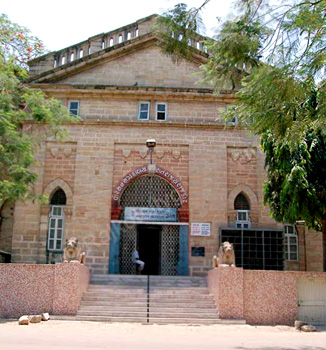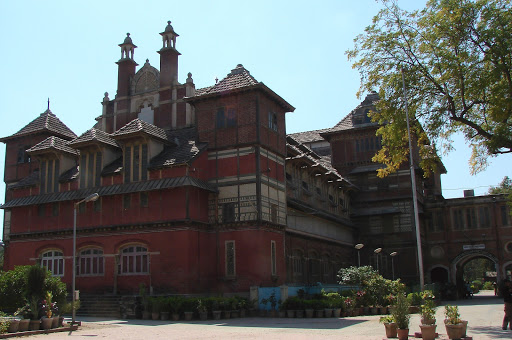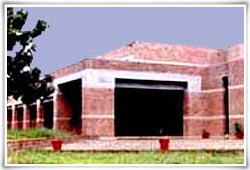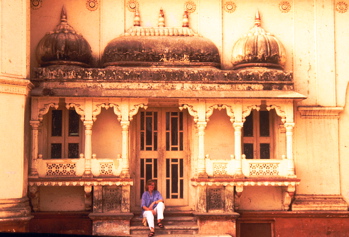Bahucharaji टेम्पले

Bahucharaji टेम्पले

Yet another Shakti tirth of Gujarat is the temple of Bahucharaji. People bring their children for the 'mundan' ceremony of their children. It is an ancient sacred site and features prominently among the' garb a - garbi' compositions in folk songs. Its older temple is 5 km away and it is quite ordinary too. But this one is very huge and grand. Its compound is also vast. On several occasions this is filled with thousands of devotees. In front of the temple is one Havankund and behind it is the home of Vallabh Bhatt Mevada who has composed a number of songs of garbis and garbas addressing the Mother Goddess. Next to the temple is Mansarovar Lake and a number of Dharmshalas for devotees and visitors.
Bahucharaji Mata is held in great honor in Gujarat. Among the most worthy places for visit near the ancient capital of Patan is this temple of Bahucharaji Mata. On full moon day of Chaitra and Aso months every year big fairs are held here. Folk dances and dramas of 'Bhavai' are also performed. The construction of this temple began in VS 1835 and it was completed in VS 1837 when the image of the Mother Goddess was ceremoniously installed.
Around this large area of the temple a fort is constructed, with four 'burj' and three Gates. This temple is ISm long and 9m wide. It has a dome and a shikhar. There is a great Mandapa facing the Garbhagriha. In the dome of this Mandapa or hall, on its pillars are painted dolls. Near the temple is one Havan or Agni kund for religious ceremonies. The open ground of the temple is popularly called 'chachar no chowk'. Near the gate of the temple is Mansarovar. On full moon day of Chaitra and Aso months people visit the temple in large numbers. The 'palkhi' procession of the Goddess is taken out to Shankhalpur. Many families come to the temple for the 'mundan' ceremony of their children when their hair is totally removed for the first time after birth as one of the 'sanskaras'.
As we move upwards from the banks of Saraswati at the historic Anhilwad Patan, we come to Siddhapur. Just as Gaya is called the best place to hold the Shradda Sanskar for one's father, Siddhpur has the honor for similar rite for one's mother. It is said that Bhagvan Parshuram had performed this rite for his Mother and since then it has acquires this sacred aura for the later generations. Thus we find that even today this significance draws thousands for this rite here.
As we read the description of Rudra Mahal in treatises of the past, we find that this 'Mahalay' was true to its name a great and vast structure, with incomparable wealth of sculptured beauty. Mularaj of the Solanki dynasty had begun to construct it and Siddhraj Jaysinh completed it. When we read the grand narration about how it contained vast public halls, other big and small halls, stories and stories full of balconies and verandahs, with richly carved pillars and other sculpted beauties, and how thousands of Brahmans chanted Mantras for worship and uttered various Stotras, we feel that it was like another Somnath temple
However, Allauddin Khilji razed it to the grounds. Gradually it almost disappeared. Today we can see only four pillars with an arch. But even these little ruins can provide us an idea about the beauty and grandeur of the original structure. In a 100 m. by 75 m wide area, it was a structure of two to three stories, with 1600 pillars and a large public meeting hall (Sabha Mandap).
We also must take a note of the legend of Rudra Mahal about the laying of the foundation of this structure. When King Mularaj Solanki dreamt of making a grand Shiv-Rudra Mahalay on the banks of River Saraswati, he summoned the famous architect Prandhar, he invited many other architects and astrologers, besides the skilled arti.sans from far and near. These experts selected the stone for the construction and began their work
After Mularaj, the great architect Prandhar also died. Then came the great successors like Bhimdev: Kamadev and even the queen Minaldevi. On the throne of Patan now came Bhattark Siddharaj Jaysinh. Someone reminded him of the great dream of his ancestor Mularaj that was still incomplete. Siddharaj now took up the bid to complete that dream
He invited Markand Shastri from Malva, a great astrologer. Under his guidance a new place for laying the foundation of Rudra Mahal was undertaken. As the ceremony was being conducted the Shastri went on instructing. He said, 'Dig here for another yard and a little more. This is the 'Siddha Ghatika, the Honored Hour. Keep your eye on the stick held here and as soon as I call out, plant this gold nail into the ground." And at the auspicious second, under Markand shastri's instruction, this was done.
Markand Shastri was jubilant, "Dhanya, this is great fortune for everyone! 0 King, now nothing, not even TIME can touch this Rudra Mahalay, it would last until the Sun and the Moon last (Yavacchandradivakarau). Maharaj, the nail has been placed into the head of the Sheshanaga, One who holds the Earth on His head. Now this is a moment in time that does not move. It has no Beginning and no End.
The King Jaysinh respectfully bowed to him and said, "Acharyavar, even Lord Brahma has not made any Creation that has no End
Markandji replied, "Maharaj, according to my astrological calculations the auspicious time cannot go wrong. Even if the Pralay or the End of the World comes, it would only bow and touch the feet of this Mahalaya."
Jaysinh, "Oh! What End of the World, Gurudev? What head of Sheshnaga? -Just where is the Head that holds the Earth deep down, and look at the 1 Y2 inch of this little gold nail that went ointo it!! Guruji, say something that we can believe! Or, prove it at least
Markandji was upset, "0 King! Do not mock or test such things of Knowledge!"
Jaysinh haughtily replied, "Acharyaji! I too want to see the proof. Can you show it to me?"
Markandji said, "Maharaj! Well, take off the nail, and you will find blood flowing out! Just see for yourself!"
After a lot of discussion if such a step must be taken or not, as the King did not abandon his stance of doubt, Markand shastri agreed for pulling the nail out, "As soon as the nail is pulled, it should be pushed back once more." He directed.
The nail was pulled and just as it was being pushed back, the clothes of Jaisinh were sprayed with blood. The nail was pushed back once more. With absolute amazement and happiness, Jaisinh looked at Markand shastri. But Mrakandji was most unhappy. He said, "Maharaj, within the few moment of pulling and pushing back the nail, Sheshanaga has shifted. Now the nail has not struck his head but his tail!!"
Jaisinh asked, "So? What does that mean?"
Markandji said, "Adhishwar! I am unhappy to say that the result of this is that since you are sprayed with the blood of Sheshanaga, you would be invincible. However. ..
Jaishinh asked, "However ... ?"
Markandji continued, "However ... it means that your name and fame would suffer, and while Rudramahal would be completed, it also would be razed in time. The ringing of bells day and night would stop one day, each of its stone would be broken up with a hammer, its grandeur and significance lost in time. Only some ruins would tell us of its grandeur .... "
Thid may only be a legend, bu is indeed very intersting. When we recall it as we stand near the remnants of Rudramahal, we experience agreat thrill.

| [Reservation] | ||
|
| [Utelia] [Reservation] | ||||
Accommodation: A total of 14 double bedrooms have been renovated to match the grandeur of the building and feature attached baths with running hot-and-cold showers, and dressing space. Some of the beds are real period pieces inlaid with mirrors and ornate decorations. Each of the rooms open onto private balconies or common verandahs with splendid views of the River Bhugavo where demoiselle and common cranes gather. Even if you are not staying here, it is worth dropping in for lunch on the way to Ahmedabad and Bhavnagar or Palitana. |
Kumbhalgarh Fort : Located 64 kms north of Udaipur in the wilderness, Kumbhalgarh is the second most important citadel after Chittorgarh in the Mewar region. Cradled in the Aravali Ranges the fort was built in the 15th century by Rana Kumbha. Because of its inaccessibility and hostile topography the fort had remained un-conquered. It also served the rulers of Mewar as a refuge in times of strife. The fort also served as refuge to the baby king Udai of Mewar. It is also of sentimental significance as it is the birthplace of Mewar's legendary King Maharana Partap.
The fort is self-contained and has within its amalgam almost everything to withstand a long siege. The fort fell only once that too to the combined armies of Mughal and of Amber for scarcity of drinking water. Many magnificent palaces an array of temples built by the Mauryas of which the most picturesque place is the Badal Mahal or the palace of the clouds. The fort also offers a superb birds view of the surroundings. The fort's thick wall stretches some 36 kms and is wide enough to take eight horses abreast. Maharana Fateh Singh renovated the fort in the 19th century. The fort's large compound has very interesting ruins and the walk around it can be very rewarding.
|
Gandhi Museum |

| [Mehsa na] | |||||
|
Baroda Museum and Picture Gallery |

Calico Museum of Textiles |







 The history of junagadh is chequered by the rules of the Mauryans, Kshatrapas, Guptas, Vilabhis, Chudasamas, Gujarat Sultans and Babi Nawabs. Junagadh, at different times in history, was under the influence of four major religions. Hindu, Bhuddhist, Jain and Muslim. Both political powers and religious influences enriched the culture and created edifices leaving their mark on the architecture of Junagadh.
The history of junagadh is chequered by the rules of the Mauryans, Kshatrapas, Guptas, Vilabhis, Chudasamas, Gujarat Sultans and Babi Nawabs. Junagadh, at different times in history, was under the influence of four major religions. Hindu, Bhuddhist, Jain and Muslim. Both political powers and religious influences enriched the culture and created edifices leaving their mark on the architecture of Junagadh.


Information
Nadiad is well known for many things. Once upon a time, people like Haridas Biharidas of Nadiad were the flames of public service. The seat of Santaram Maharaj and the Santaram Temple earned fame not only for its religious importance, but for the public service activities also. Nadiad was also the land of laureates and literatures during the later years of l9th century and beginning of the instant. The author of the epic like Gujarati novel 'Saraswatichandra' Govardhanram Tripathi, Mansukhram Shivaram,
Zaverilal Yagnik, Ranchhodbhai Udayram, Manilal Nabhubhai, Balashanker, the poet-painter Phoolchand Master, Rasakavi Raghunath Brahmbhatt were a few of the many literary personalities. The residence of Govardhanram has been preserved like a monument and his statue has been placed in the heart of the town.
Nadiad has developed into a trade centre. There are many hospitals and educational institutions. The Kidney Hospital, Dharmasingh Desai Institute of Technology and the Ayurvedic College are well known throughout.
Nadiad reminds us of a great personality. He was known as pujya Mota. His original name was Chunilal Asharam Bhavsar. Surajba was his mother. For want of economic resources, he could not obtain his higher education after matriculation. Those were the days of Gandhiji. Under the influence and instructions of Gandhiji, he dedicated himself to the service of the nation and to activities for the upliftment of Harijans. He devoted himself to all these activities to such an extent, that he fell seriously ill. The physical misery led him to the notion of committing suicide. But he was saved in one such attempt.
Kutch City of Gujarat State
T here are buses to Anjar every 30 minutes from the bus stand in Bhuj. To Lilpur, there is one direct bus at 30 am (Rs 20). Or take one of the many buses to Rapar and get another bus from there. Alternatively, ask the driver on the bus to Rapar to drop you off at the turn-off to Lilpur, and walk the three km to the village.From Ahmedabad, take a bus to Dasada, 12km north-east of Zainabad (two hours, Rs 23). From here there are local buses to Zainabad. There are also direct buses from Rajkot. Alternatively, taxis which take up to four people can be arranged through Desert Coursers for around Rs 4.50 per km.
here are buses to Anjar every 30 minutes from the bus stand in Bhuj. To Lilpur, there is one direct bus at 30 am (Rs 20). Or take one of the many buses to Rapar and get another bus from there. Alternatively, ask the driver on the bus to Rapar to drop you off at the turn-off to Lilpur, and walk the three km to the village.From Ahmedabad, take a bus to Dasada, 12km north-east of Zainabad (two hours, Rs 23). From here there are local buses to Zainabad. There are also direct buses from Rajkot. Alternatively, taxis which take up to four people can be arranged through Desert Coursers for around Rs 4.50 per km.







